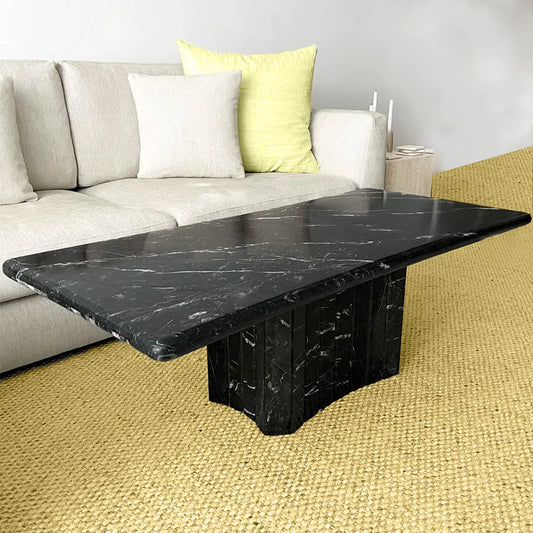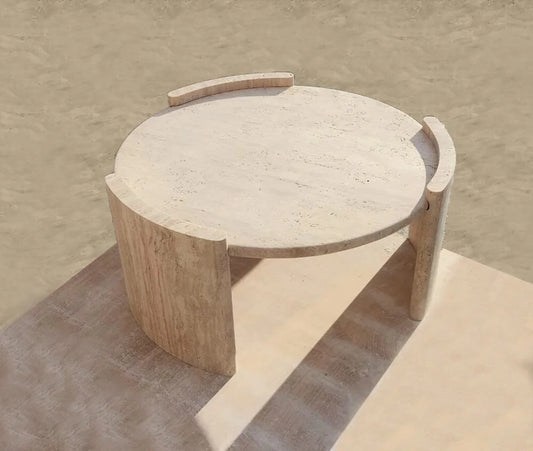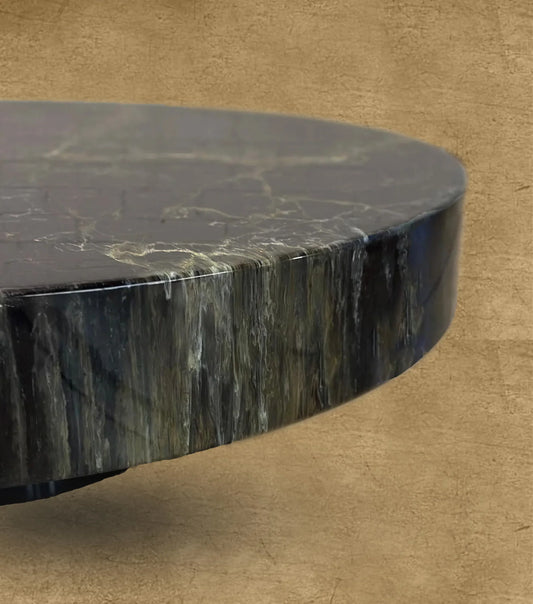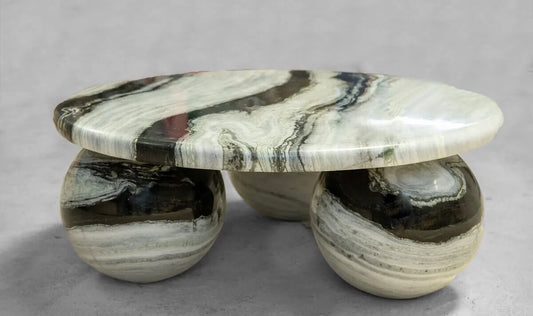-
Rectangle Black Marble Coffee Table With Hourgalss Base
Regular price From Dhs. 1,750.00Regular price From Dhs. 1,750.00 Sale priceUnit price per -
Beige Travertine Coffee Table
Regular price Dhs. 10,500.00Regular price Dhs. 10,500.00 Sale priceUnit price per -
Black Circular Marble Coffee Table
Regular price From Dhs. 7,100.00Regular price From Dhs. 7,100.00 Sale priceUnit price per -
Round Jungle Green Coffee Table Bol Base
Regular price From Dhs. 8,459.00Regular price From Dhs. 8,459.00 Sale priceUnit price per
Comprehending Travertine
Travertine is a natural stone with warm and earthy tones. Hot springs as well as other mineral-rich environments are responsible for the formation of this limestone, or to be precise, by calcium carbonate precipitation from mineral-rich water. Besides, its wide popularity makes it useful for building and decoration. Another important unique property is its porous texture.
Some of the key characteristics encompass the texture which can have either small holes or pits, due to the trapped air bubbles during the formation. Also, this stone of elegance has a variety of colors, typically light, such as cream, beige and brown.
This Al Arfah Technical stone in UAE or elsewhere is also quite durable and can resist wearing as well as scratching. It also wins in withstanding high temperatures, due to which it is a good choice for kitchen countertops or slabs. If you are taking enough care of it, this stone with high porosity can last for decades or even centuries.
Furthermore, travertine is a sedimentary rock, which means that accumulation as well as solidification of the earth's surface's sediments are the reasons behind its formation. Examples of such sediments include organic matter, weathering debris and chemical precipitates.
Travertine Marble
'Travertine marble' is a term often used for this stone, however, it is technically incorrect. This stone, whether available in Dubai or elsewhere, is not marble. Both these are well-famed, natural materials, nevertheless, different from each other.
Marble stone is generally denser and smoother than the other and even is more resistant to staining. Also, it is costlier. On the other hand, the use of travertine and marble is quite similar because of their aesthetic appeal and sturdiness.
Additionally, tuff, gypsum and marcello are also different from this sedimentary limestone, please keep in mind. There is travertine porcelain too, which is an imitation travertine, and is basically a porcelain tile that encompasses a design appearing very much like this stone.
Types of Travertine: The Natural Stone
In case you are opting for furniture made of travertine, you must know that they come in many kinds and hues.
Travertino Classico: Travertine Italian or Italian Travertine, is a well-famed variety from Tivoli, central Italy. The name signifies timeless beauty as well as historical worth. This town in Italy has been a source of this material for centuries, with its use in ancient Rome architecture. Also, it appears warm beige.
Travertine Giallo: It is also known as Yellow Travertine and has warm as well as golden-brown color. There are various locations from where it can be sourced contrary to what its name suggests. Those locations are Turkey, Egypt and Iran. Wall cladding and countertop are among its uses.
Ebony Travertine: This is undoubtedly one of the darkest kinds and used both indoors and outdoors, like patio and tabletops. Its primary hue is deep brown, the variety of colors from grey or gold are basically the hints in it. Besides, it also has a porous texture.
Tivoli Travertine: Other names are Lapis Tiburtinus (stone of Tibur) and Roman Travertine. This cream-colored material has a range of other shades as well, including brown and gold. The hardness makes it a unique and useful option for high-traffic living spaces. Besides, it has subtle veining patterns.
Beige Travertine: This is Classic Travertine, with more names, such as Cream Travertine and Ivory Travertine. Its neutral shade makes it an excellent option for interior and exterior applications. Moreover, this travertine has many uses and has been known since ancient times; still seen in structures like the Colosseum, Il Teatro Flavio.
Silver Travertine: This is another marvel of sedimentation. Basically, it is a blend of luxury and modernity because of its silver-gray color. Shimmering is one of its key properties, alongside veining and texture. Moreover, it goes well for decorative accents as well.
White Travertine: Or Bianco Travertine, is a very nice option for attaining a clean look. It has a porous surface too, with high durability, suitable for many uses. The example includes flooring and countertops. Besides, this travertine is quarried in Italy, Iran and Turkey.
Red Travertine: This striking material has lighter shades of red to deep burgundy ones, alongside subtle veining in lighter hues. Also, it is durable and can hardly be categorized as light travertine. It is mainly quarried in Iran. You can consider it to decorate your terrace.
Walnut Travertine: Or Noce Travertine, this one has visible pits and holes on its surface, just like many other kinds. Using travertine of this kind seems apt for flooring because of warm tones. Also, this makes it adaptable to different design styles, including rustic, traditional and modern.
Albestino Travertine: The porous texture is there, for sure, but this one has delicate as well as subtle veining in hues like gray and brown. From among the calcium carbonate minerals, pick it for adding warmth alongside elegance. Its another name is Cream Travertine.
Marina Travertine: One more, best for indoor and outdoor applications is Golden Brown Travertine. It has a warm, golden-brown color with veining. Also, the earthy tones makes this stone an apt option for multiple design styles of, for instance, dining tables.
Mosaic Travertine: This is a tile, which is made of small pieces of this stone. Outdoors, walls and backsplashes are common uses. Moreover, it has many colors and shapes.
Titanium Travertine: It has a dark gray hue with some silver and brown. This feature makes this type stand out from other travertines. Also, it is long-lasting.
Cuts & Finishes
Among the diversity of cuts, two are famous, including vein cut and Fleuri cut. The latter is also the cross cut, runs parallel to the bedding plane, depicting a haphazard pattern. This can produce durable floor tiles, but fails to be useful for high-traffic areas. If cut making follows the vein or is against the bedding planes, then it is the vein cut.
Next, let's grasp about finishes, starting from polished travertine, which is common and polishing gives it a very glossy surface. Another is honed one, popular for residential use and is ideal for backsplashes too. Moreover, there are tumbled and brushed types; one having distressed look, perfect for rustic home styles while the other has a more textured appearance.
Advantages & Disadvantages
- Think of travertine as a highly advantageous stone, because of natural beauty, exhibiting color variations and veining. This aesthetic appeal makes it suitable for different applications, letting you create stunning styles and contrasts.
- Another benefit is for nature lovers because this material is natural and hence is eco-friendly.
- And don't underestimate its strength or durability. It has the ability to resist wear and tear.
- In our opinion, not everyone might like its porous texture and the latter is susceptible to staining as well, in case you have failed to properly maintain it.
- Moreover, this calcite containing stone requires special care and you must prevent using any acidic substance on it, otherwise, this can eat away the surface.
Taking Care of Travertine
- Clean it regularly and ensure to remove dust and debris.
- Instantly wipe up the stills in order to prevent staining. You can use a mild cleaner and a soft cloth.
- Talk to a professional for sealing recommendations and ponder on it after every one to 2 years.
Collapsible content
Are lesser holes a representation of good-quality travertine?
Are lesser holes a representation of good-quality travertine?
Smaller holes are often linked with its higher quality. However, it is vital to keep in mind other aspects as well, including color consistency, higher mineral content and overall appearance.
Is your high-quality travertine very expensive?
Is your high-quality travertine very expensive?
No, our products are never too expensive, ensuring people can relish luxurious furniture at reasonable prices. You can explore our furniture, encompassing side tables.
Is it a natural stone?
Is it a natural stone?
Yes, it is basically a precipitation of calcium carbonate and a type of limestone. Also, it has distinctive holes and patterns.
Is it non-slip?
Is it non-slip?
This factor relies on the finish. If it is polished, the surface will be highly slippery when wet. The honed one has much better slip resistance. Furthermore, the most slip resistant option is the tumbled stone.
Can I make brown travertine at home?
Can I make brown travertine at home?
It is not possible to make it at home as its formation is in fact a natural process. However, you can work on DIY techniques, such as painting, to attain surfaces that look quite like this stone.










